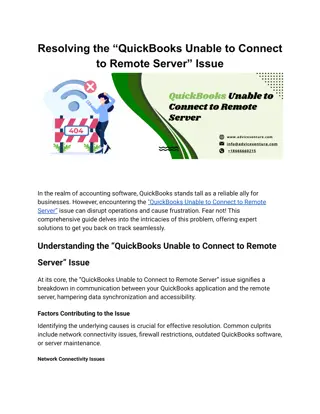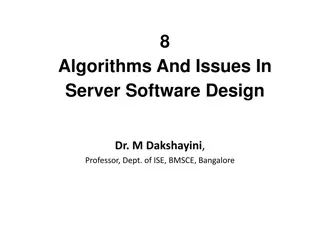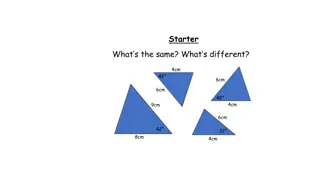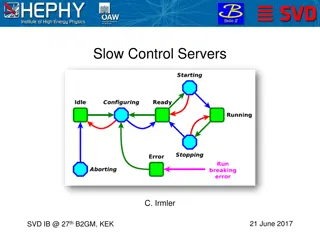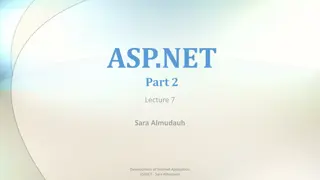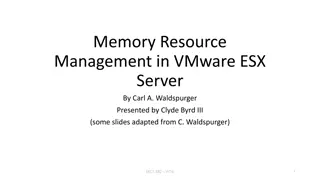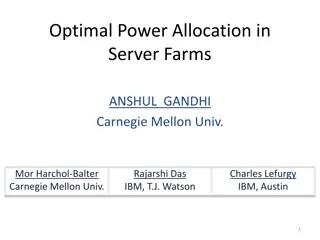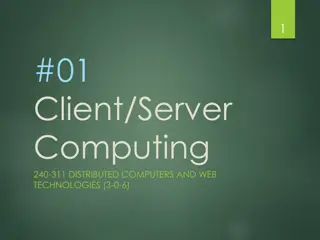
Server-Side Programming and Multi-Document Transactions
Dive into the world of server-side programming with a focus on multi-document transactions. Learn about stored procedures, bounded execution, and the transaction continuation model in JavaScript. Explore the benefits, logic, and execution within time boundaries provided by stored procedures in programming. Discover how JavaScript functions can implement a continuation-based model for long-running transactions and efficiently handle bulk document creation.
Download Presentation

Please find below an Image/Link to download the presentation.
The content on the website is provided AS IS for your information and personal use only. It may not be sold, licensed, or shared on other websites without obtaining consent from the author. If you encounter any issues during the download, it is possible that the publisher has removed the file from their server.
You are allowed to download the files provided on this website for personal or commercial use, subject to the condition that they are used lawfully. All files are the property of their respective owners.
The content on the website is provided AS IS for your information and personal use only. It may not be sold, licensed, or shared on other websites without obtaining consent from the author.
E N D
Presentation Transcript
Programming Run native JavaScript server-side programming logic to performic atomic multi-record transactions. GEEK This module will reference programming in the context of the SQL API.
Stored Procedures Benefits Familiar programming language Atomic Transactions Built-in Optimizations Business Logic Encapsulation
Simple Stored Procedure function createSampleDocument(documentToCreate) { var context = getContext(); var collection = context.getCollection(); var accepted = collection.createDocument( collection.getSelfLink(), documentToCreate, function (error, documentCreated) { context.getResponse().setBody(documentCreated.id) } ); if (!accepted) return; }
Multi-Document Transactions Database Transactions In a typical database, a transaction can be defined as a sequence of operations performed as a single logical unit of work. Each transaction provides ACID guarantees. In Azure Cosmos DB, JavaScript is hosted in the same memory space as the database. Hence, requests made within stored procedures and triggers execute in the same scope of a database session. Stored procedures utilize snapshot isolation to guarantee all reads within the transaction will see a consistent snapshot of the data Create New Document Update Existing Document Delete Existing Document Query Collection
Bounded Execution Execution Within Time Boundaries All Azure Cosmos DB operations must complete within the server-specified request timeout duration. If an operation does not complete within that time limit, the transaction is rolled back. Helper Boolean Value All functions under the collection object (for create, read, replace, and delete of documents and attachments) return a Boolean value that represents whether that operation will complete: If true, the operation is expected to complete If false, the time limit will soon be reached and your function should end execution as soon as possible.
Transaction Continuation Model CONTINUING LONG-RUNNING TRANSACTIONS JavaScript functions can implement a continuation-based model to batch/resume execution The continuation value can be any value of your own choosing. This value can then be used by your applications to resume a transaction from a new starting point Bulk Create Documents Observe Return Value Each Try Create Done Document Return a pointer to resume later
CONTROL FLOW Javascript Control Flow Stored procedures allow you to naturally express control flow, variable scoping, assignment, and integration of exception handling primitives with database transactions directly in terms of the JavaScript programming language. ES6 Promises ES6 promises can be used to implement promises for Azure Cosmos DB stored procedures. Unfortunately, promises swallow exceptions by default. It is recommended to use callbacks instead of ES6 promises.
Stored Procedure Control Flow function createTwoDocuments(docA, docB) { var ctxt = getContext(); var coll = context.getCollection(); var collLink = coll.getSelfLink(); var aAccepted = coll.createDocument(collLink, docA, docACallback); function docACallback(error, created) { var bAccepted = coll.createDocument(collLink, docB, docBCallback); if (!bAccepted) return; }; function docBCallback(error, created) { context.getResponse().setBody({ "firstDocId": created.id, "secondDocId": created.id }); }; }
Stored Procedure Control Flow function createTwoDocuments(docA, docB) { var ctxt = getContext(); var coll = context.getCollection(); var collLink = coll.getSelfLink(); var aAccepted = coll.createDocument(collLink, docA, function(docAError, docACreated) { var bAccepted = coll.createDocument(collLink, docB, function(docBError, docBCreated) { context.getResponse().setBody({ "firstDocId": docACreated.id, Nesting your callbacks is just as valid of a method as using named callback functions "secondDocId": docBCreated.id }); }); if (!aAccepted) return; }); if (!bAccepted) return; }
Rolling Back Transactions Transaction Roll-Back Inside a JavaScript function, all operations are automatically wrapped under a single transaction: If the function completes without any exception, all data changes are committed If there is any exception that s thrown from the script, Azure Cosmos DB s JavaScript runtime will roll back the whole transaction. Implicit Implicit BEGIN TRANSACTION COMMIT TRANSACTION Update Existing Document Create New Document Query Collection Delete Existing Document Implicit Transaction Scope ROLLBACK TRANSACTION If exception, undo changes
Transaction Rollback in Stored Procedure collection.createDocument( collection.getSelfLink(), documentToCreate, function (error, documentCreated) { if (error) throw "Unable to create document, aborting..."; } ); collection.createDocument( documentToReplace._self, replacementDocument, function (error, documentReplaced) { if (error) throw "Unable to update document, aborting..."; } );
Debugging Stored Procedures CONSOLE LOGGING Much like with traditional JavaScript applications, you can use console.log() to capture various telemetry and data points for your running code. VIEWING SCRIPT LOGS .NET You must opt-in to viewing and capturing console output using the EnableScriptLogging boolean property available in the client SDK. The SDK has a ScriptLog property on the StoredProcedureResponse class that contains the captured output of the JavaScript console log.
Debugging Stored Procedures var response = await client.ExecuteStoredProcedureAsync( document.SelfLink, new RequestOptions { EnableScriptLogging = true } ); String logData = response.ScriptLog;
Debugging Stored Procedures RequestOptions requestOptions = new RequestOptions(); requestOptions.EnableScriptLogging = true; StoredProcedureResponse response = client.executeStoredProcedure( storedProcLink, requestOptions, new Object[]{} );
D E M O Authoring Stored Procedures
User-Defined Functions UDF User-defined functions (UDFs) are used to extend the Azure Cosmos DB SQL API s query language grammar and implement custom business logic. UDFs can only be called from inside queries They do not have access to the context object and are meant to be used as compute-only code
User-Defined Function Definition var taxUdf = { id: "tax", serverScript: function tax(income) { if (income == undefined) throw 'no input ; if (income < 1000) return income * 0.1; else if (income < 10000) return income * 0.2; else return income * 0.4; } }
User-Defined Function Usage In Queries SELECT * FROM TaxPayers t WHERE udf.tax(t.income) > 20000 SQL
D E M O Authoring User-Defined Functions


